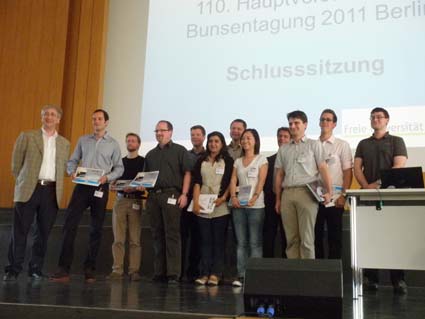Top 25 most-read PCCP articles for Q1
Air and water stable ionic liquids in physical chemistry
Frank Endres and Sherif Zein El Abedin
DOI: 10.1039/B600519P
Colloidal metal nanoparticles as a component of designed catalyst
Chun-Jiang Jia and Ferdi Schüth
DOI: 10.1039/C0CP02680H
Titania supported gold nanoparticles as photocatalyst
Ana Primo, Avelino Corma and Hermenegildo García
DOI: 10.1039/C0CP00917B
Density functional theory for transition metals and transition metal chemistry
Christopher J. Cramer and Donald G. Truhlar
DOI: 10.1039/B907148B
Controlled nanostructures for applications in catalysis
Ferdi Schüth
DOI: 10.1039/C1CP90005F
Theory of gold on ceria
Changjun Zhang, Angelos Michaelides and Stephen J. Jenkins
DOI: 10.1039/C0CP01123A
Studying disorder in graphite-based systems by Raman spectroscopy
M. A. Pimenta, G. Dresselhaus, M. S. Dresselhaus, L. G. Cançado, A. Jorio and R. Saito
DOI: 10.1039/B613962K
Towards large-scale, fully ab initio calculations of ionic liquids
Ekaterina I. Izgorodina
DOI: 10.1039/C0CP02315A
Fullerene derivative acceptors for high performance polymer solar cells
Youjun He and Yongfang Li
DOI: 10.1039/C0CP01178A
Catalysis by metal–organic frameworks: fundamentals and opportunities
Marco Ranocchiari and Jeroen Anton van Bokhoven
DOI: 10.1039/C0CP02394A
New nanostructured heterogeneous catalysts with increased selectivity and stability
Ilkeun Lee, Manuel A. Albiter, Qiao Zhang, Jianping Ge, Yadong Yin and Francisco Zaera
DOI: 10.1039/C0CP01688H
Processes in chemical reactions related to the environment, energy and materials sciences
Li-Jun Wan
DOI: 10.1039/C0CP90160A
The role of molecular modeling in confined systems: impact and prospects
Keith E. Gubbins, Ying-Chun Liu, Joshua D. Moore and Jeremy C. Palmer
DOI: 10.1039/C0CP01475C
‘Shape effects’ in metal oxide supported nanoscale gold catalysts
Matthew B. Boucher, Simone Goergen, Nan Yi and Maria Flytzani-Stephanopoulos
DOI: 10.1039/C0CP02009E
Optical imaging of excited-state tautomerization in single molecules
Anna M. Chizhik, Regina Jäger, Alexey I. Chizhik, Sebastian Bär, Hans-Georg Mack, Marcus Sackrow, Catrinel Stanciu, Alexey Lyubimtsev, Michael Hanack and Alfred J. Meixner
DOI: 10.1039/C0CP02228D
CO bond cleavage on supported nano-gold during low temperature oxidation
Albert F. Carley, David J. Morgan, Nianxue Song, M. Wyn Roberts, Stuart H. Taylor, Jonathan K. Bartley, David J. Willock, Kara L. Howard and Graham J. Hutchings
DOI: 10.1039/C0CP01852J
The mystery of gold’s chemical activity: local bonding, morphology and reactivity of atomic oxygen
Thomas A. Baker, Xiaoying Liu and Cynthia M. Friend
DOI: 10.1039/C0CP01514H
Bimetallic Pt–Au nanocatalysts electrochemically deposited on graphene and their electrocatalytic characteristics towards oxygen reduction and methanol oxidation
Yaojuan Hu, Hua Zhang, Ping Wu, Hui Zhang, Bo Zhou and Chenxin Cai
DOI: 10.1039/C0CP01998D
Theoretical investigation of formation mechanism of bipyridyl molecule on Ni(111) surface: implication for synthesis of N-doped graphene from pyridine
Hui Feng, Zhaosheng Qian, Chen Wang, Congcong Chen and Jianrong Chen
DOI: 10.1039/C0CP02441D
Layer-by-layer assembly as a versatile bottom-up nanofabrication technique for exploratory research and realistic application
Katsuhiko Ariga, Jonathan P. Hill and Qingmin Ji
DOI: 10.1039/B700410A
A photo-induced electron transfer study of an organic dye anchored on the surfaces of TiO2 nanotubes and nanoparticles
Marcin Ziółek, Ignacio Tacchini, M. Teresa Martínez, Xichuan Yang, Licheng Sun and Abderrazzak Douhal
DOI: 10.1039/C0CP01898H
Molecular states of water in room temperature ionic liquids
L. Cammarata, S. G. Kazarian, P. A. Salter and T. Welton
DOI: 10.1039/B106900D
Carbon materials for supercapacitor application
Elzbieta Frackowiak
DOI: 10.1039/B618139M
Electronic coherences and vibrational wave-packets in single molecules studied with femtosecond phase-controlled spectroscopy
Richard Hildner, Daan Brinks, Fernando D. Stefani and Niek F. van Hulst
DOI: 10.1039/C0CP02231D
Aspect ratio dependence on surface enhanced Raman scattering using silver and gold nanorod substrates
Christopher J. Orendorff, Latha Gearheart, Nikhil R. Jana and Catherine J. Murphy
DOI: 10.1039/B512573A
















